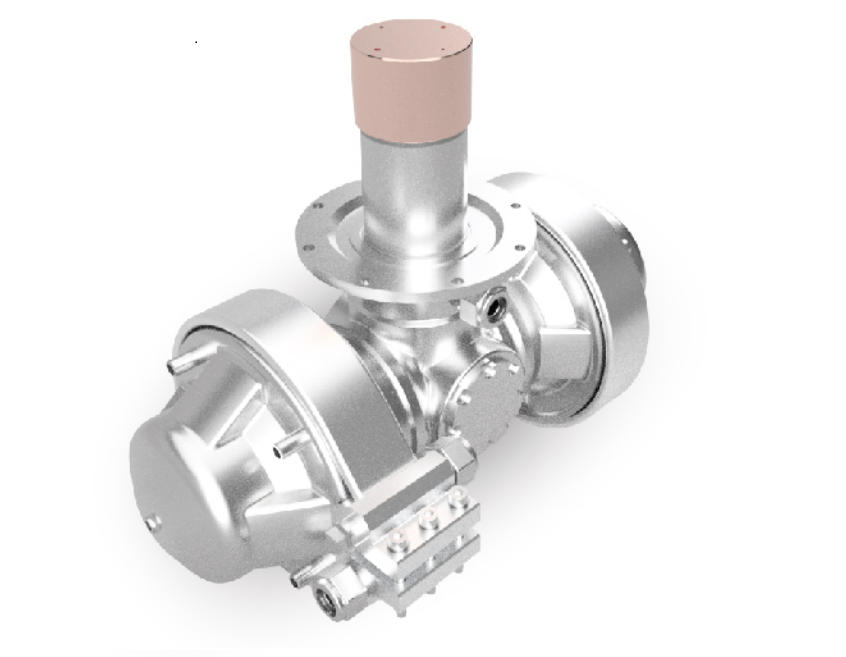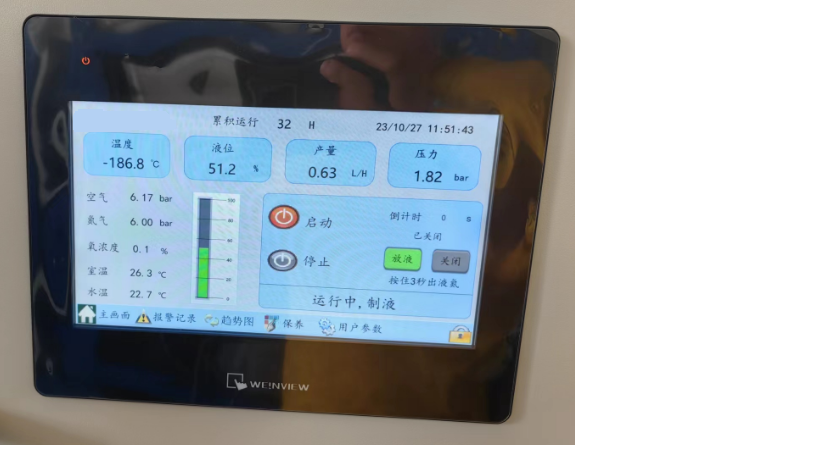ACLN2-50S – Industrial-Grade LN₂ Generator for Heavy-Duty Use
The ACLN2-50S is a high-capacity, water-cooled LN₂ generator designed for industrial and large-scale research applications, offering 50 liters per day of ultra-clean LN₂.
Key Features:
✅ LN₂ Production: 50 L/day
✅ Built-in Dewar: 100 L
✅ Purity: >99.5%
✅ Pressure: 3.0 bar
✅ Low Noise: <65 dB (@1m)
✅ Power Consumption: 7.3 kW
✅ Cooling System: Water-cooled
✅ Weight: 600 kg
The robust build and automated operation make it an ideal choice for pharmaceutical, food processing, and high-tech manufacturing industries.
ACLN2 S Series – ALLUM Liquid Nitrogen Generators
The ACLN2 S Series liquid nitrogen generators redefine on-site LN₂ production with an integrated design, combining an air source, nitrogen source, cryo-cooler, and a built-in dewar tank. These systems deliver high-purity liquid nitrogen automatically, ensuring efficiency and ease of operation via a user-friendly touchscreen interface.
Key Features & Advantages
✅ Reliable & Efficient Cryocooler
Utilizing advanced hybrid Pulse Tube and Gifford-McMahon (GM) cryocoolers, the ACLN2 S series ensures stable, energy-efficient LN₂ generation. Certified with EU CE & UL safety standards, these cryocoolers provide long-term reliability and minimal maintenance.
✅ High-Purity LN₂ Production
• Built-in Pressure Swing Adsorption (PSA) nitrogen generator with an analyzer ensures 99.7% – 99.995% purity.
• Non-welded high-strength aluminum adsorption tower (max. 16 bar pressure) prevents contamination and leakage.
• Ultra-High Purity Carbon Molecular Sieve (UHP CMS) for extended lifespan.
•Dust removal filters (precision <0.01 μm) guarantee only clean nitrogen is liquefied.
✅ Smart & Automated Operations
•10” HMI touchscreen displaying essential parameters (temperature, pressure, LN₂ level, and output).
•Intelligent liquid level gauge for automatic start/standby mode, ensuring a continuous LN₂ supply.
•Ultra-low temperature solenoid outlet for controlled LN₂ dispensing without manual valve operation.
✅ Robust & Industrial-Grade System
•Siemens PLC control system for long-term stability.
•Industrial-grade electrical components with solid-state relays and physical emergency stop functions.
• Built-in oil-free air compressor (GAST or THOMAS), CE & UL certified, ensuring low noise and long service life.
✅ Remote Monitoring & IoT Integration
•WiFi & 4G remote control via Weincloud for real-time monitoring, diagnostics, and alarm notifications.
•Secure SSL/TLS encryption for data protection and system security.
✅ Optimized for Laboratories & Industrial Applications
•Compact, modular design reduces footprint and facilitates easy maintenance.
•Built-in large-capacity dewar tank eliminates the need for external LN₂ storage.
•Lower energy consumption with automatic standby function.
•Low noise operation (<60 dB @1 meter), making it ideal for laboratory environments.
Why Choose ALLUM’s ACLN2 S Series?
✔ Cost-effective: Eliminates nitrogen delivery costs and reduces operational expenses.
✔ Eco-friendly: No nitrogen emissions, 100% liquefaction efficiency.
✔ Flexible & Scalable: Wide range of models to fit different production needs.
✔ Global Support: Long-lasting components, easy maintenance, and worldwide availability.
The ACLN2 S Series is a plug-and-play solution for industries such as medical research, cryostorage, NMR, low-temperature superconductivity, cryo-EM, and astronomical observatories, ensuring a reliable and uninterrupted liquid nitrogen supply.
Maintenance free cryo-cooler
Advanced mixed type pluse tube cryo-cooler,no leakage risk of helium or refrigerant gas , expected continuous running time is over 120,000 hours
Large dewar tank
High capacity liquid dewar tank with precise level gauge,it produce and storage liquid nitrogen as per setting level
High purity liquid nitrogen
PSA nitrogen system generates nitrogen gas between 99.5% to 99.995%, N2 purity can be read on touch screen
Clean liquid nitrogen
Additional particle filter and bacterial filter installed to ensure only clean and bacterial free nitrogen gas is liquefied
WiFi and 4G internet
10 inch HMI touch screen with WiFi and 4G function. You can monitor and operate the generator remotely on mobile phones or laptops anytime, anywhere
Automatic dispensing
liquid nitrogen can be dispensed out by touching screen thanks to cryogenic solenoid valve ,and automatically stops as per value you set
Technology of ACLN Nitrogen Liquefier
-
Overview
PSA (Pressure Swing Adsorption) Nitrogen Generator is a device used to produce high-purity nitrogen gas from compressed air. It operates based on the principle of pressure swing adsorption, which involves alternating pressure to separate nitrogen from the other gases in the air.
How PSA Cycle Works
The PSA cycle involves coordinated pressure swings in the adsorbent beds to selectively adsorb and desorb gases. There are four main steps:
Feed Pressurization – The bed is brought online and feed air enters, increasing the pressure. Nitrogen passes through while oxygen and argon are adsorbed.
Production – The bed stays pressurized and continues producing nitrogen until the adsorbent nears saturation.
Depressurization – The bed is taken offline and pressure drops, causing adsorbed gases to desorb.
Regeneration – A small amount of product nitrogen purges the bed, prepping it for the next cycle.
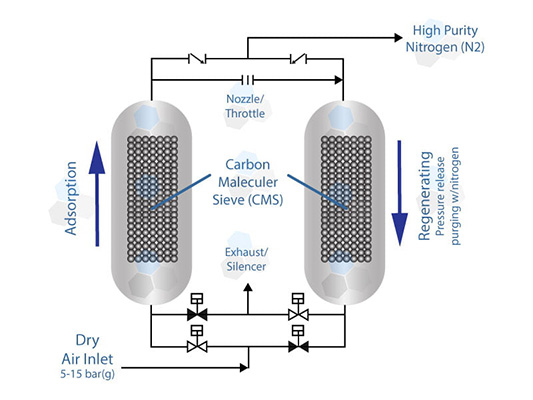
-
Advantages
PSA Nitrogen Generators offer several advantages, making them a popular choice for industries requiring a reliable source of high-purity nitrogen. Here are some key advantages:
· Cost-Effective: PSA nitrogen generators can significantly reduce costs compared to purchasing nitrogen cylinders or liquid nitrogen. On-site generation eliminates transportation, storage, and handling costs.
· Continuous Supply: These generators provide a continuous, on-demand supply of nitrogen, ensuring that operations are not interrupted by the depletion of gas supplies.
· High Purity Levels: PSA technology can produce nitrogen at various purity levels, often up to 99.999%, which can be tailored to specific application requirements.
· Energy Efficiency: PSA systems are generally more energy-efficient than other nitrogen production methods, reducing operational costs over time.
· Low Maintenance: PSA nitrogen generators have relatively low maintenance requirements, especially when compared to other nitrogen production methods. This reduces downtime and maintenance costs.
· Compact and Scalable: These systems are typically compact and can be easily integrated into existing facilities. They are also scalable, allowing businesses to increase nitrogen production as needed.
· Environmental Benefits: On-site nitrogen generation reduces the carbon footprint associated with transporting and storing nitrogen cylinders or liquid nitrogen. This contributes to more sustainable and environmentally friendly operations.
· Safety: Generating nitrogen on-site reduces the risks associated with handling high-pressure cylinders or liquid nitrogen, enhancing overall workplace safety.
· Flexibility: PSA nitrogen generators can be adjusted to produce nitrogen at different purities and flow rates, providing flexibility to meet changing operational needs.
Integrated Filtration and Drying Module
-
Overview
The most important purpose of compressed air treatment is to remove pollutants and moisture from the compressed air. Condensed water in compressed air systems can corrode, leading to microbial reproduction and long-term harm to industrial production. High humidity of compressed air can lead to failure of air control components, increased wear, or other failures in the production process.
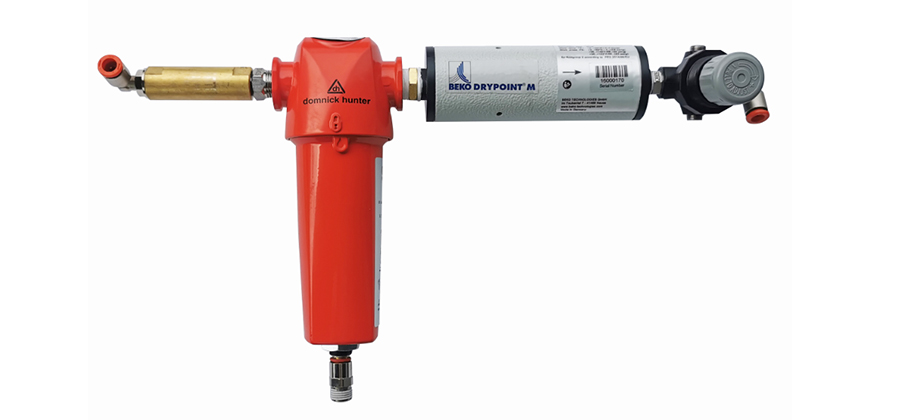
1. High performance requirement:
Dry air pressure dew point requirements vary with different applications. However, these requirements always include that the minimum energy consumption is achieved and that the dried compressed air must be ready for immediate use.
The prerequisite for achieving these requirements is a complete product range of different grades, as well as the manufacturer's accurate grasp of the performance characteristics of the dryer under different working conditions.
-
2. High Efficiency and Energy Saving:
The DRYPOINT® M PLUS diffused drying membrane pack with built-in nanoscale filter cartridge is an innovative solution that integrates filtration and drying in one housing. It requires only a small amount of backblowing to achieve reliable compressed air drying, does not consume electricity, and does not contain desiccant harmful to the environment. The built-in nanoscale filter improves the reliability of the drying film set and compressed air quality, while also increasing the long-term stability of the high permeability hollow fiber tube. The superior properties of DRYPOINT® M PLUS are also suitable for air-breathing drying processes.
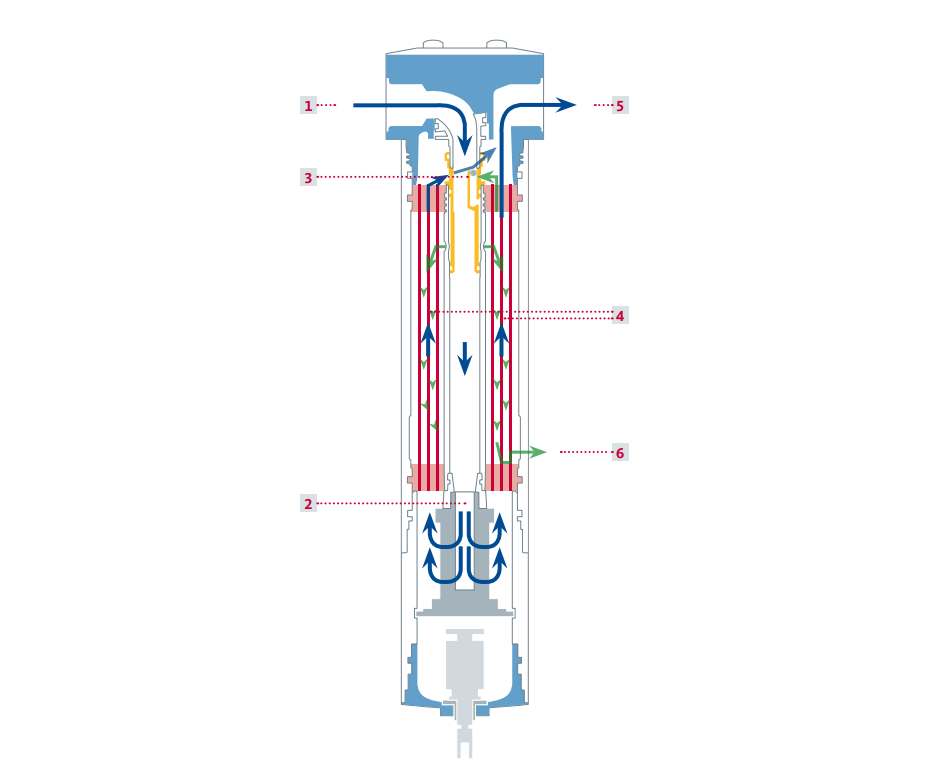
Reliable PLC Controlling Units
-
Overview
Programmable Logic Controller, also known as PLC, is a type of industrial computer used to control and automate manufacturing processes, machinery, and other systems. Integrated to modern industrial automation, PLC offers a robust, flexible, and cost-effective solution for industrial automation and control.
Integrated Siemens CPU, Weidmueller connect power, Schneider contactors and breakers and ABB interface relay, Allum's LNS series liquid nitrogen generators' PLC units exhibite unparalleled advantages than competitive products in operation, LN2 generation, liquid level control, working efficiency and reliability.
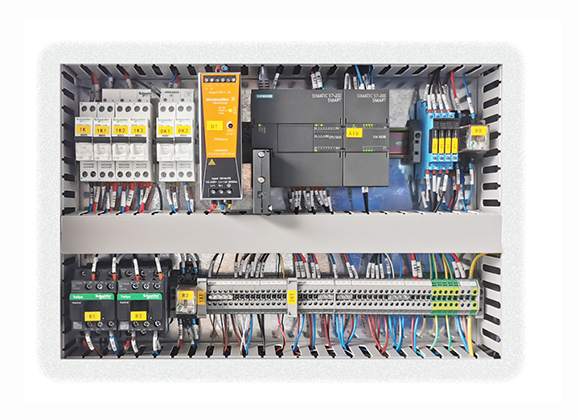
Advantages of PLC
1. Reliability and Durability
Robust Design: PLCs are designed to operate in harsh industrial environments, including extreme temperatures, humidity, dust, and electrical noise.
Long Lifespan: PLCs have a long operational lifespan with minimal maintenance requirements, ensuring continuous operation.
2. Real-Time Operation
Immediate Response: PLCs process inputs and outputs in real-time, providing immediate response to changes in the controlled process.
Consistent Performance: Ensures consistent and precise control of industrial processes.
3. Ease of Maintenance and Troubleshooting
Diagnostic Functions: PLCs come with built-in diagnostics and monitoring tools to detect and report faults, simplifying troubleshooting.
Modular Replacement: Faulty modules can be quickly replaced without affecting the entire system, minimizing downtime.
4. Enhanced Safety
Fail-Safe Mechanisms: PLCs can be programmed with fail-safe operations to ensure safety in case of system faults or failures.
Compliance with Safety Standards: Many PLCs are designed to comply with international safety standards, ensuring they meet regulatory requirements.
5. Data Collection and Monitoring
Data Logging: PLCs can log data from the controlled processes, which can be used for analysis, optimization, and predictive maintenance.
Remote Monitoring: PLCs can be accessed and monitored remotely, allowing for real-time oversight and adjustments.
6. Flexibility and Adaptability
Programmability: PLCs can be easily reprogrammed to handle different tasks, making them highly adaptable to changing production needs.
Modular Structure: Many PLCs have a modular design, allowing for easy expansion or reconfiguration by adding or removing modules.
7. Scalability
Suitable for Various Applications: PLCs can be used in small, medium, and large-scale automation systems, from simple control tasks to complex processes.
Expandable: Additional I/O modules and communication interfaces can be added to meet increasing demands.
8. User-Friendly Programming
Standardized Programming Languages: PLCs use standardized programming languages like Ladder Logic, Function Block Diagram (FBD), and Structured Text (ST), which are relatively easy to learn and use.
Simulation and Testing: Many programming environments offer simulation tools to test and debug the control logic before deploying it to the actual system.
9. Interoperability and Communication
Wide Range of Communication Protocols: PLCs support various communication protocols (e.g., Modbus, Ethernet/IP, PROFINET, DeviceNet) to integrate with other devices and systems.
Network Integration: PLCs can be integrated into larger networked systems, enabling centralized monitoring and control.
Advanced Pulse Tube Cryocooler
-
Overview
Pulse Tube Cryocoolers (PTCs) are advanced, reliable, and efficient systems with unique design, which eliminates moving parts in the cold section, provides significant benefits in terms of durability, low vibration, and noise, making them ideal for sensitive and critical applications.
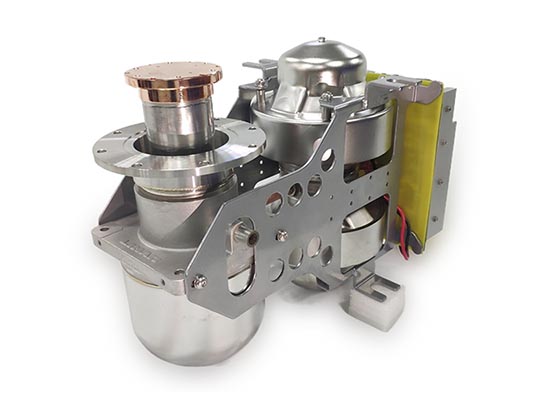
Performance
Pulse Tube Cryocoolers (PTCs) are advanced, reliable, and efficient systems with unique design, which eliminates moving parts in the cold section, provides significant benefits in terms of durability, low vibration, and noise, making them ideal for sensitive and critical applications.
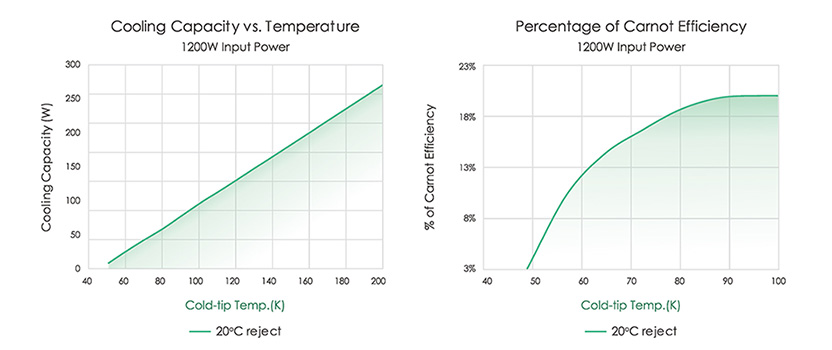
-
Advantages
1. No Moving Parts in the Cold Section:
Reduced Mechanical Wear: Since PTCs have no moving parts in the cold region, there is minimal mechanical wear, leading to increased system reliability and longevity.
Low Maintenance: The absence of moving parts reduces the need for regular maintenance and repairs, lowering operational costs and downtime. Allum's LN2 generators coolers have an expected over 100,000 hours life span.
2. Low Vibration and Noise:
Suitable for Sensitive Applications: The low vibration and noise levels make PTCs ideal for applications that require a stable environment, such as precision instrumentation, infrared detectors, and scientific experiments.
Environmental Benefits: Reduced noise contributes to a quieter and more comfortable working environment.
3. High Reliability:
Long Service Life: The design's inherent reliability ensures a long service life, making PTCs dependable for critical applications.
Stable Operation: High reliability translates to consistent performance with minimal risk of unexpected failures.
4. High Efficiency:
Energy Efficiency: PTCs are designed to optimize heat exchange and thermodynamic efficiency, resulting in a high coefficient of performance (COP).
Energy Savings: The high efficiency of PTCs helps reduce energy consumption, leading to cost savings and a lower environmental footprint.
For more information or to request a quote, contact ALLUM today!
